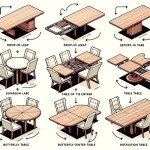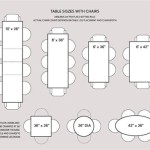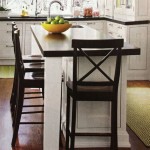Understanding the Ideal Size of an 8-Person Round Dining Table
Selecting the appropriate dining table is a crucial decision for any home. The dining table is not just a surface for meals; it serves as a central gathering point for family and friends. For larger households or those who frequently entertain, an 8-person round dining table can be an excellent choice. However, determining the ideal size for such a table requires careful consideration of several factors, including room dimensions, seating comfort, and overall aesthetics. This article will delve into the various aspects that influence the optimal size of an 8-person round dining table.
A round table fosters conversation and creates a more intimate dining experience compared to rectangular or square alternatives. The circular shape allows each person to see and interact with everyone else at the table, promoting a sense of connection and inclusivity. An 8-person capacity makes it suitable for families with multiple children or those who often host dinner parties or social gatherings. Choosing the right size ensures that each guest has ample space to dine comfortably without feeling cramped or restricted.
Assessing Room Dimensions and Space Requirements
The most critical factor in determining the appropriate size for an 8-person round dining table is the available space within the dining area. Before even considering specific dimensions, one must measure the length and width of the room. This foundational step ensures that the table will fit comfortably without obstructing walkways or making the space feel overcrowded.
A general rule of thumb for dining room space is to allow at least 36 inches (91 cm) of clearance between the edge of the table and any walls or furniture. This clearance allows individuals to move freely around the table, pull out chairs easily, and avoid bumping into surrounding objects. Ideally, this clearance should be closer to 42-48 inches (107-122 cm) for optimal comfort, especially in frequently used dining areas.
To calculate the minimum room size required for an 8-person round dining table, the diameter of the table must be considered in conjunction with the recommended clearance. For instance, if the table is 60 inches (152 cm) in diameter, an additional 36 inches of clearance on each side needs to be factored in. This means the room should be at least 132 inches (335 cm) wide and long to accommodate the table comfortably. If the room is smaller than this, a smaller table or a different shape may be more appropriate.
Beyond the basic clearance around the table, additional space considerations should be taken into account. If the dining room includes other furniture, such as a buffet, sideboard, or china cabinet, the space required for these pieces must be factored into the overall room dimensions. Leave sufficient space so that these items can be accessed easily without interfering with the dining area.
The location of doorways and windows also plays a role in determining the optimal table size. Ensure that the table does not obstruct doorways or interfere with the opening and closing of windows. Natural light can significantly enhance the dining experience, so consider the placement of the table in relation to windows to maximize the benefits of daylight.
Determining the Ideal Diameter for Seating Comfort
Once the available space has been assessed, the next step is to determine the ideal diameter for the 8-person round dining table. The diameter directly impacts seating comfort and the amount of space available for each diner. Insufficient space can lead to an uncomfortable dining experience, while excessive space can make conversation difficult.
A minimum diameter of 60 inches (152 cm) is typically recommended for an 8-person round dining table. This size allows each person approximately 23.5 inches (60 cm) of personal space along the circumference of the table. While this is a reasonable minimum, some may find it slightly cramped, especially when accounting for serving dishes and personal belongings.
A diameter of 60 to 72 inches (152-183 cm) is generally considered the sweet spot for an 8-person round dining table. This size provides a comfortable amount of space for each diner, allowing for ample elbow room and sufficient space for plates, glasses, and cutlery. It also leaves enough room in the center of the table for serving dishes and decor without making the table feel cluttered.
For those who prefer a more generous dining experience or require extra space for elaborate table settings, a diameter of 72 inches (183 cm) or larger may be preferable. However, it is important to remember that increasing the diameter also increases the overall footprint of the table and the space required to accommodate it comfortably. Therefore, careful consideration of room dimensions is essential.
When selecting the diameter, consider the types of chairs that will be used with the table. Chairs with arms typically require more space than those without arms. Measure the width of the chairs and factor this into the overall calculation to ensure that each chair fits comfortably around the table without bumping into adjacent chairs.
The height of the table is also an important factor. Most dining tables have a standard height of 28 to 30 inches (71-76 cm). Ensure that the chairs are of an appropriate height relative to the table so that diners can sit comfortably without feeling too high or too low.
Material, Style, and Aesthetic Considerations
Beyond size and space, the material and style of the dining table play a crucial role in its overall appeal and integration with the existing decor. The choice of material can affect the table's durability, maintenance requirements, and aesthetic qualities. Similarly, the style of the table can impact the ambiance of the dining room and reflect one's personal taste.
Common materials for dining tables include wood, glass, metal, and stone. Wood tables are a classic choice, offering warmth and versatility. Different types of wood, such as oak, maple, walnut, and cherry, offer varying degrees of durability, grain patterns, and color tones. Glass tables provide a modern and minimalist aesthetic, but may require more frequent cleaning to maintain their appearance. Metal tables are durable and often used in industrial or contemporary designs. Stone tables, such as marble or granite, offer a luxurious and durable option, but can be quite heavy and expensive.
The style of the table should complement the overall design of the dining room. A traditional dining room might benefit from a wood table with ornate carvings and a rich finish. A modern dining room might be better suited to a glass or metal table with clean lines and a minimalist design. A rustic dining room might feature a reclaimed wood table with a distressed finish.
The base of the table is another important design element to consider. Round dining tables can have a variety of base styles, including pedestal bases, trestle bases, and four-legged bases. Pedestal bases offer a clean and uncluttered look, while trestle bases provide stability and visual interest. Four-legged bases are a classic choice and offer a more traditional appearance.
Consider the color and finish of the table in relation to the other elements in the dining room. The color of the table should complement the walls, flooring, and other furniture in the room. The finish of the table can affect its sheen and texture. A high-gloss finish can create a more formal and polished look, while a matte finish can create a more casual and relaxed feel.
Ultimately, selecting the ideal size, material, and style for an 8-person round dining table involves a careful balance of practical considerations and personal preferences. By assessing room dimensions, determining seating comfort, and considering aesthetic factors, one can choose a table that enhances both the functionality and beauty of the dining area.
In addition to the above considerations, it is also worthwhile to explore expandable round dining tables. These tables offer the flexibility to accommodate additional guests when needed. An expandable table typically includes one or more leaves that can be inserted to increase the table's diameter, allowing it to comfortably seat more than eight people. This can be particularly useful for those who occasionally host larger gatherings but do not have the space for a large dining table on a regular basis.
Finally, it is recommended to visit furniture stores and showrooms to physically experience different table sizes and styles before making a final decision. Sitting at a table and evaluating its comfort and dimensions firsthand can provide valuable insights that can't be obtained through online research alone. This hands-on approach ensures that the selected 8-person round dining table is not only aesthetically pleasing but also functionally suitable for one's specific needs and preferences.

Round Dining Tables Connecticut In Style Table Dimensions Sizes 8 Person

Circular Tables Are Space Efficient Designed With A Variety Of Common Diameters Small Roun Round Dining Room Table Sizes

Tablecloth Size Chart Tavolo Tondo In Resina Arredamento

Buy Glass Choosing The Right Dining Table Top

Dining Table Dimensions Measurements

Revit Family Round Dining Tables Post Digital Architecture

Dining Table Size

How To Build A Round Table Top With Free Patterns In Diffe Sizes Ana White

Creative 8 Person Dining Table Size For Your Eoyment
What Size Dining Table Seats 6 Quora








